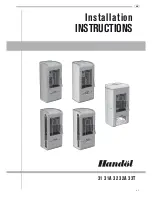
the fold on the clamping plate is in line with the lugs on the firebox as
shown in Fig.4. Ensure that the clamping plate does not prevent the
throat plate from seating correctly. All flue connections must be well
sealed.
It is possible to pass a 16 inch diameter sweep’s brush through the
appliance but in most back outlet installations it will be necessary to
have a soot door to enable the chimney to be swept. The optional
vertical rear flue connector does allow the chimney to be swept
through the stove.
SOOT DOORS
PRE LIGHTING CHECK
COMMISSIONING
Soot doors may either be in the actual brickwork of the chimney or
in the register plate. Various positions of soot doors are shown in
Figs. 5 to 8.
Ensure that the throat plate is fitted in the roof of the appliance. The
location and positioning of the throat plate is shown in Fig. 3.
Check that the front fence is fitted correctly and that the door closes
properly.
On completion of the installation allow a suitable period of time for
the fire cement and mortar to dry out before lighting the fire. If no
grate is fitted make a layer of ash or sand on the base of the stove
before lighting. Check to ensure that smoke and fumes are taken
from the appliance up the chimney and emitted safely. Also check all
joints and seals. On completion of the installation and commissioning
please leave the operating instructions with the customer and advise
them on the use of the appliance.
Under the Clean Air Act local authorities may declare the whole or
part of the district of the authority to be a smoke control area. It is an
offence to emit smoke from a chimney of a building, from a furnace
or from any fixed boiler if located in a designated smoke control area.
It is also an offence to acquire an "unauthorised fuel" for use within a
smoke control area unless it is used in an "exempt" appliance
("exempted" from the controls which generally apply in the smoke
control area).
The Secretary of State for Environment, Food and Rural Affairs has
powers under the Act to authorise smokeless fuels or exempt
appliances for use in smoke control areas in England. In Scotland and
Wales this power rests with Ministers in the devolved administrations
for those countries. Separate legislation, the Clean Air (Northern
Ireland) Order 1981, applies in Northern Ireland. Therefore it is a
requirement that fuels burnt or obtained for use in smoke control
areas have been "authorised" in Regulations and that appliances used
to burn solid fuel in those areas (other than "authorised" fuels) have
been exempted by an Order made and signed by the Secretary of
State or Minister in the devolved administrations.
The
has been recommended as suitable for use
in smoke control areas when burning wood logs.
Further information on the requirements of the Clean Air Act can be
found here: http://smokecontrol.defra.gov.uk/
Your local authority is responsible for implementing the Clean Air Act
1993 including designation and supervision of smoke control areas
and you can contact them for details of Clean Air Act requirements.
CAA AND SMOKE CONTROL
The Clean Air Act 1993 and Smoke Control Areas
Charnwood C-FOUR
11
®
INSTALLATION INSTRUCTIONS
Register Plate
With Soot Door
Alternative
Soot Door Positions
Fig. 8. Horizontal Register Plate With Optional
Vertical Rear Flue Connector
Содержание C-Four
Страница 1: ...Operating Installation Instructions charnwood ...
Страница 2: ......
Страница 8: ......
Страница 15: ......


































